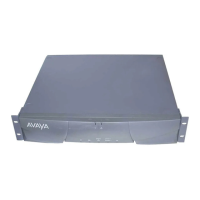Maintenance-Object Repair Procedures
555-233-143
8-484 Issue 1 May 2002
Customer-Provided Alarming Device Test (#115)
Within a specified EPN, the Customer-Provided Alarming Device (CPAD) test
closes the relay that activates the CPAD for 1 minute. If more than 1 minute is
necessary to verify the CPAD’s activation, the Repeat field on the test
customer-alarm UUC command can be used to close the relay for up to
99 minutes.
However, when the repeat option is used, the results for Test #115 come back
immediately and, for each test that passed, the CPAD is kept on for that many
minutes. The CPAD does not go off after 1 minute and then come back on.
Instead, the CPAD is kept on continuously for the entire time. If the CPAD is being
activated and deactivated in a flickering fashion, there is a problem with either the
CPAD or an EPN’s Maintenance circuit pack.
Table 8-193. Test #115 Customer-Provided Alarming Device Test
Error
Code
Tes t
Result Description / Recommendation
Any ABORT Internal system error
1. Retry the command at 1-minute intervals up to 5 times.
PASS The switch software successfully sent the request to the EPN’s Maintenance
circuit pack to turn on the CPAD. The CPAD must be physically inspected to
verify that it is working.
1. If the CPAD is working but a customer complains that the CPAD did not
indicate an actual system alarm:
a. Enter display system-parameter maintenance to check the
administered alarm-activation level.
b. Compare this level with the customer’s specifications. If the level does
not match the customer’s specifications, change it using the change
system-parameter maintenance form.
2. If Test #115 passes but the CPAD is not being activated, check the CPAD’s
connection to the EPN’s Maintenance circuit pack.
3. If the CPAD can be activated but not deactivated, enter status
port-network to verify that Emergency Transfer is not activated in the
affected EPN.
Emergency Transfer can be forced to manual OFF via the Emergency
Transfer switch on the EPN’s Maintenance circuit pack.
4. If Emergency Transfer is OFF and the CPAD still cannot be deactivated:
a. Enter display system-parameter maintenance to check the
administered CPAD alarm levels.
b. Enter display alarms to compare the CPAD levels against those
currently present in the system.
Continued on next page

